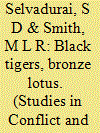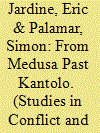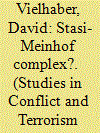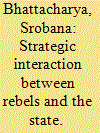| Srl | Item |
| 1 |
ID:
121894


|
|
|
|
|
| Publication |
2013.
|
| Summary/Abstract |
Although much has been written on the Sri Lankan state's civil war with the Liberation Tigers of Tamil Eelam (LTTE), less has been said about how the conflict's dynamics evolved. How did the parties come to utilize the methods they did? Why did the war become so brutal, characterized by a predisposition toward extreme violence on both sides? Using the typology of "dirty war," this investigation seeks to address such questions, demonstrating how the strategic choices of the main belligerents shaped the conflict. The analysis shows that while the conflict emerged out of deep-rooted social and ethnic divisions, these factors do not account for how the war came to be defined so comprehensively by the methods of dirty war. It finds that dirty war developed from a sporadic tactic to advance political goals to dominant military practice by a reciprocal process of escalation that eventually internalized dirty war as the accepted mode of strategic communication.
|
|
|
|
|
|
|
|
|
|
|
|
|
|
|
|
| 2 |
ID:
121896


|
|
|
|
|
| Publication |
2013.
|
| Summary/Abstract |
Canada's counterinsurgency in Kandahar province, Afghanistan, involved two distinct operational strategies: an initial enemy-centric strategy and, after 2009, a population-centric strategy. Using insurgent-initiated attacks against civilians as a measure for the level of control and security provided by the counterinsurgency, this article tests the effectiveness of these two strategies using a quasi-experimental research design. This article finds that a population-centric counterinsurgency strategy that aimed to provide security to the population rather than destroy the insurgency resulted in the most controlled and secure environment for the civilian population. To the extent that a secure civilian population is important for successful counterinsurgency, the post-2009 population-centric operational strategy of the Canadian Forces, International Security Assistance Force (ISAF), and the United States increased the chances of a successful counterinsurgency in Afghanistan.
|
|
|
|
|
|
|
|
|
|
|
|
|
|
|
|
| 3 |
ID:
121893


|
|
|
|
|
| Publication |
2013.
|
| Summary/Abstract |
The extent of the East German Ministry for State Security's involvement with militant left-wing terrorist organizations that operated in West Germany remains one of the most contentious issues with respect to the legacy of left-wing terrorism in Germany. Fueled by new archival evidence and much speculation, the topic has been the subject of many unfounded and sensationalist assertions. This article seeks to provide a chronological reassessment based on the current state of knowledge, and thus seeks to make a contribution to a growing literature on state involvement with terrorist groups. While the East German spy agency at times colluded with terrorist groups, the degree of support fluctuated considerably and there is no evidence that a state actor "created" the armed groups or "directed" their activities.
|
|
|
|
|
|
|
|
|
|
|
|
|
|
|
|
| 4 |
ID:
121895


|
|
|
|
|
| Publication |
2013.
|
| Summary/Abstract |
The "people's war" in Nepal during 1996-2006, led to two significant outcomes-the elimination of monarchy and political victory for the Maoists. These political outcomes raise important questions about the process of Maoist conflict in Nepal. While several studies on political conflict are concerned about "why" such conflicts happen, I focus on "how" the strategy of conflict unfolded in Nepal. In this article, I argue that strategic interaction between rebels and the state explain why the conflict led to negotiated settlement in Nepal. To discuss the sequence of rebel-state interaction, I introduce a game theoretic model. In addition, I show how territorial control, target selection, and levels of violence used by the rebels in comparison to the state are crucial in understanding the conflict process. The case study in this article analyzes the relevance of rebel-state interaction to reveal micro processes of political conflict and further suggests that negotiation can become an important tactical choice in resolving conflict.
|
|
|
|
|
|
|
|
|
|
|
|
|
|
|
|